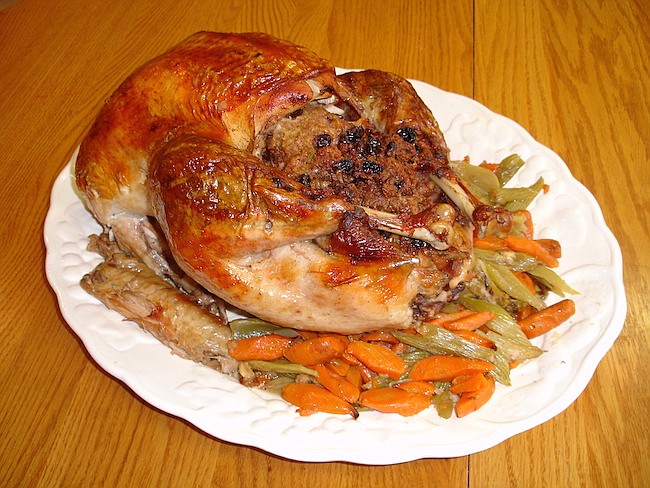- July 26, 2024
-
-
Loading

Loading

DEAR PAW'S CORNER: I know you warn people every holiday season about the dangers of their pets ingesting certain foods, like chocolate, onions and grapes. I wanted to share my experience from last Thanksgiving, when my terrier, "Blake," sneaked into the kitchen and started eating leftovers off of plates piled on the counter.
We were alerted by the crash of several plates onto the floor. Fortunately, we stopped Blake from trying to lick up spilled food amid the shattered dishes, but he had eaten a lot of high-fat foods — stuffing, gravy, you name it — that were loaded with spices, onions and other ingredients.
I kept a close eye on Blake over the next several hours, and made sure the emergency vet's number was on hand. Sure enough, Blake started looking lethargic and vomited; we put him in the car and drove right to the vet. Because I called ahead, they were able to treat him immediately, and he recovered without any lasting problems.
I hope my experience can help other pet owners as the busy, distracting holiday season descends on us. – Relieved Mom in Pittsburgh
DEAR RELIVED MOM: It certainly can! Thank you for sharing your experience. Keeping the emergency veterinarian's number close by — added to a mobile phone's contact list, written next to other key numbers on the refrigerator — is very important during holidays, when many vets' offices are closed.
And of course, because holiday gatherings can be distracting, it may be best to keep pets in a secure, comfortable area away from loud noise and tempting foods.
DEAR PAW'S CORNER: I wanted to add to your recent columns about feral cats. Maybe some can't be tamed, but my friends and family would disagree.
I recently visited with friends in North Carolina and met their beautiful cat, "Stormy." Their story is this: They had been feeding this feral cat for some time outside, and of course, he wouldn't come near them. Then one night they heard a howling outside. Looking out, they saw a mountain lion or panther, whatever they call them there, threatening Stormy. They opened the door, and Stormy came in, and never went outside again.
Another story I have is of a feral cat that was "adopted" by my son's chickens! He has six chickens in his backyard in Florida, and one day someone dropped off a very young kitten. He got into the coop, but instead of running or attacking, the kitten assumed those chickens were his parents! Now a full-grown cat, he remains mostly feral and won't come inside my son's house, but he hangs out in the chicken coop daily with his new family.
Hope your readers enjoy the stories! – John S., via email
DEAR JOHN: What amazing stories! I'm glad both cats found loving homes and new families. Thank you for sharing them.
It's rare for feral cats to be coaxed inside and become fully domesticated cats that are comfortable around humans. But for those that do find a home — even if they never quite cross the threshold of the house — life can be happier and more rewarding for them as well as the humans who care for them.
DEAR PAW'S CORNER: I've had a lot of trouble training my Dalmatian, "Damian," to behave around other dogs and people. It has really limited our outdoors time, which is very disappointing because I always envisioned bringing him around to my favorite neighborhood spots, playing in the dog park and having him in the same room with friends. What can I do to fix his bad behavior? ¬– Jeff T., Atlanta
DEAR JEFF: Although I always stress the importance of daily training in basic behavior, and how important it is to socialize puppies to both humans and other dogs, sometimes following these basics still isn't enough.
I think of training as an investment in your dog. The more often you invest, the better the returns in terms of behavior and bonding. However, you've got to consider the quality of that training investment, too — as well as each dog's individual temperament and capacity for learning.
Many inexperienced dog owners learn to train as they go. Some breeds of dogs help them along a bit — I remember as a kid, our family's Golden retriever "Saucy" actually kept us to a routine training and walking schedule — but other dogs aren't so easy to train or willing to learn. They're not bad dogs, just different.
So, when your best efforts aren't quite enough, it's time to look for help. A professional trainer can help you figure out what's going on with Damian, find weak spots in his training regime and offer key techniques that training books often don't have or can't adequately describe. Meet with a few trainers in your area to find the right one, and keep building on that investment — and relationship — with Damian. It's well worth it.
Send your questions or tips to [email protected].
(c) 2016 King Features Synd., Inc.